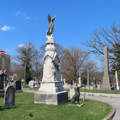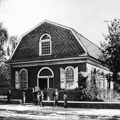Brandywine Creek had long afforded Wilmingtonians with recreation: walks, picnics, bathing, skating. A proposal for the city to buy land on its banks was rejected in a town meeting in 1865. Three years later, the threat of houses going up between Wilmington and Brandywine Cemetery (WL48) and Rattlesnake Run upstream led to an outcry. A committee was established in 1868–1869 and recommended a Brandywine Park, the fast-flowing rocky river being a scenic amenity few other American cities could boast. Still, nothing was done.
In 1881, textile magnate William P. Bancroft complained that Wilmington was growing fast, with scarcely any provision for parks or open spaces of any kind—except cemeteries. Two years later, he pushed the state legislature to set up the Wilmington Board of Park Commissioners, to which his cousin, banker and botanist William M. Canby, was appointed. Canby wrote to Frederick Law Olmsted, famous Boston landscape designer, who accepted an invitation to visit Wilmington. Olmsted reported (in December 1883) that the city should move quickly to purchase both banks of the river, which it did, buying 115 acres in 1886–1887. Olmsted did not design the park, however. Instead, credit should go to the Wilmington Board of Park Commissioners, along with Samuel Canby and Theodore A. Leisen.
By 1908, the park embraced 178 acres, and the scenic Brandywine raceways were depicted on innumerable postcards. Recent years have seen an effort to rid the park of invasive plant species, and Brandywine Zoo has been refurbished (Homsey Architects). The State Division of Parks took over Brandywine Park in the 1990s, with positive results, and scholar Susan Mulchahey Chase has recently written a history.
Writing Credits
If SAH Archipedia has been useful to you, please consider supporting it.
SAH Archipedia tells the story of the United States through its buildings, landscapes, and cities. This freely available resource empowers the public with authoritative knowledge that deepens their understanding and appreciation of the built environment. But the Society of Architectural Historians, which created SAH Archipedia with University of Virginia Press, needs your support to maintain the high-caliber research, writing, photography, cartography, editing, design, and programming that make SAH Archipedia a trusted online resource available to all who value the history of place, heritage tourism, and learning.











